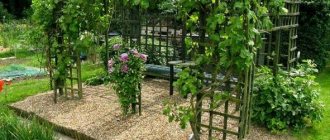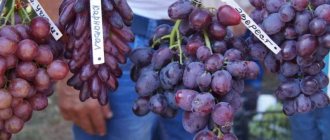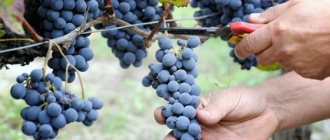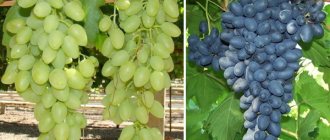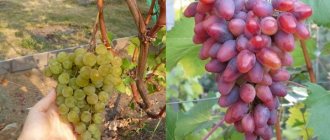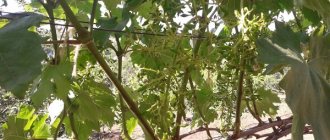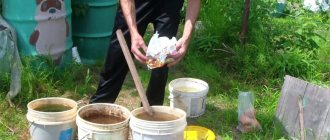The table grape variety Velika, which means “big” in Bulgarian, is a recent guest on domestic farms and household plots. Despite the fact that more than thirty years have passed since its appearance, it became widespread in the post-Soviet space only in recent years, but it instantly attracted the attention of winegrowers thanks to its very large, tasty, dark-colored berries and the high marketability of the bunches in general. At a certain moment, the interest in the “new product” was so great that its seedlings at a certain stage were several times more expensive than other, no less worthy varieties. The word “new” is placed in quotation marks for a reason. After all, if we plunge into the history of the appearance of Velika, we learn that it was bred in 1987 at the Institute of Agriculture and Seed Production “Obraztsov Chiflik” (Russe, Bulgaria), and in 1997 it passed the state variety test in its homeland and was included to the local register of varieties approved for use. For many years it has been widespread and popular throughout the Balkan Peninsula, as well as in Turkey and even in northern Africa - in particular in Morocco. He came to our country much later, having begun his triumphal march with a rush of interest in him, which has only slightly subsided by now.
The author of the bestseller is Ivan Todorov, a professor at the above-mentioned Institute. To breed it, the scientist crossed the old Turkish grape Karaburnu (Bolgar) with another “veteran” - the French Alphonse Lavalier, and subsequent self-pollination of the resulting hybrid. At one time, Alphonse Lavalier served as the father form for the even more famous Cardinal variety. By the way, the Bulgarian Velika turned out to be somewhat better in terms of unpretentiousness and disease resistance than its American half-brother, although it was not far behind it in terms of frost resistance. However, despite all the costs and labor intensity of cultivation in a temperate climate, fans of our hero remain crazy about it, continuing to actively propagate and expand the geography of its cultivation.
It is also worth mentioning Velika not only because of the giant berry, but also because of the fantastic growth power associated with its inherent transgression of this trait, passed on from its parents. Thanks to such powerful development, the variety became very popular with the residents of Crimea and the Black Sea coast of the Caucasus, where it works very well in arched and arbor formations, without fear of damage to uncovered grape bushes by low winter temperatures.
Description of Velika grapes
Velika is a red table grape variety. Used for cultivation by amateurs and professionals.
According to the description of the variety, Velika grapes differ from other types due to their large size. The gardener is forced to engage in formation within three months after planting the bush. To control the growth of grapes, it is necessary to use vigorous rootstocks (varieties used: Monticola, Chasny, Berdagdieri). This also has a positive effect on the yield and the size of the bunches. The supports for the Velika reach three meters. Not only adult bushes are tied up, but also shoots.
Pollination occurs independently due to the presence of flowers of both sexes. No other grape varieties are required for propagation on the site.
The leaves have a rounded shape with a deep cut. The top of the leaf is smooth and the bottom is rough. The number of blades is from 5 to 7.
The bunch has a cone-shaped shape. The berries are located quite densely on it. The weight of one bunch ranges from 600 to 1000 g. Record values are considered to be weights up to 1500 g.
The size of the fruits themselves is large: length up to 39 mm, width up to 25 m, weight about 15 g. The berries have an elongated oval shape, often pointed towards the tip. The fruits are dark blue in color, often coated with natural wax, which is necessary to protect the Velika grape variety.
The skin of Velika grapes is dense, but not hard. Thanks to this, the fruits are protected from external irritants and mechanical damage. The pulp of the variety is pink, crispy, most often without seeds.
Growing and care
Landing
- We choose the most illuminated place on the site, it’s good if there is protection from the north in the form of a fence or building (the distance to the foundation is at least 70 cm), groundwater should be no closer than 1.5 m to the surface, you should absolutely not choose a place in the shade trees, in addition to shading, a larger plant will draw nutrients onto itself.
- We maintain a distance between bushes of 2.0-2.5 m, and leave the same distance between the rows. Crop rotation is a fashionable trend, but in small areas it is poorly implemented, so in my case I plant grapes after uprooting grapes and everything grows beautifully.
- We are preparing a nutrient mixture, the composition is indicated in the pictures below, the size of the planting hole is 60x60x60 cm, there is no point in digging deeper and wider.
- When planting, pour about 15 cm of the nutrient mixture, scatter a little black soil on top so that there is no direct contact of the roots with the nutrient mixture, install the seedling, straighten the roots in different directions (if the seedling is not just dug up, but purchased, then we renew the roots by cutting off the tips ), sprinkle with black soil and then with nutritious soil. It is also good to sprinkle the roots with the preparation Vallar, which protects the roots of Velika from the larvae of the cockchafer.
- We fill the hole to about 10-15 cm, we do not fill the entire hole, a small amount of soil will warm up faster and the seedling will take root faster. We water it with two buckets of water and shade the seedling for the first 2 weeks.
Velika is sold in almost every nursery, perhaps this is why there is a lot of mismatch. Often, instead of Velika, Black Bolgar is found; it is easiest to distinguish the two varieties by their green berries; Velika’s berries are oval, elongated, while Bolgar’s have the tip retracted inward.
The distance between bushes in a row is 2.5 m, row spacing is also 2.5 m.
Hole dimensions: depth 60 cm, length and width 50 cm.
Composition for filling the hole:
Why do we bury the seedling when planting? In most of Russia, grapes need to be covered for the winter. In our case, deep planting and the heel of the bush at a depth of about 40 cm will allow us to form sleeves of the bush from the ground; it will be easier to pin them to the ground for the winter and bury or cover them.
Feeding
Feeding can be different, I will tell you about my scheme, which I consider very economical and which gives good results.
In spring and the first half of summer, Velika needs nitrogen. I use mullein. I don’t infuse it, I just dilute a bucket of mullein with a bucket of water and mix it. Around the bushes I make baths with earthen sides about 10 cm high, fill them with water and add about 2.0 kg to the water. mullein for each bush. I mix the mullein with the water that fills the bath. I carry out this feeding at the end of May, in mid-June and at the end of June.
Since August 1, I have been giving potash fertilizers, which contribute to better ripening of the vines. Potassium monophosphate is used, fertilizing frequency is once a week, the initial concentration is 40-50 g/10 l. water, each subsequent feeding increases the concentration by 10 g, until we reach a value of 120 g/10 l. water.
In late autumn I apply rotted manure to the vineyard. In a layer of 5-7 cm, not only under the bushes, but also between the rows.
Processing by leaf in May. Nitrogen content 30%
Processing by leaf in June. A large amount of phosphorus stimulates the formation of a large number of inflorescences
Since August 1st we have been using the 5:15:45 train. The minimum amount of nitrogen will not allow the shoots to fatten, the vine will ripen well
Watering
Characteristics of the variety
Velika grapes are wonderful berries belonging to the table variety. Thanks to the large size of the grapes, as well as their unusual delicate taste, Velika is popular among buyers.
Drought resistance, frost resistance
Velika can withstand cold down to -22 degrees Celsius. This is not enough, especially in the northern zone. When growing a variety in the middle zone, if the temperature drops, you will need to take care of shelter.
Productivity and fruiting
Velika grapes are early ripening varieties (ripen at the end of August). The plant has an average fruiting period. You can get ripe berries already on the 135th day of ripening. A gardener can get about 10 kg of fruit from one bush. Reviews about the Velika grape variety indicate that the taste of the berries is sweet and sour, sweetness predominates due to the ability to accumulate sugar (about 19 g/100 cm2). The taste is reminiscent of plum or prune.
Area of application of fruits
The berries are used for fresh consumption. Wine is not made from it. It is often grown commercially for further sale, which is made possible by its thick skin. It allows the variety to be transported without damage. Velika is perfectly stored if the temperature is maintained.
Resistance to diseases and pests
The Velika variety has poor disease resistance. If a disease is not detected in time, the gardener will lose the entire harvest. Phylloxera and birds pose a particular danger to berries. Wasps are not so dangerous; they cannot bite through the thick skin of Velika grapes.
Important! If the fruit is “ravaged” by insects, then the smell from the berry will attract other insects.
Advantages and disadvantages of the variety
Advantages of Velika grapes:
- taste and aroma of berries;
- possibility of long-term storage;
- possibility of transportation without loss of presentation;
- high productivity;
- wasps cannot bite through the dense peel of the variety;
- the berries are strong and healthy due to the presence of flowers of both sexes.
Disadvantages of Velika grapes:
- weak immunity to diseases;
- too rapid growth of bushes;
- average winter hardiness.
Despite the existing disadvantages of the variety, the gardener will be able to eliminate them and enjoy the taste of the grapes.
Needs shelter for the winter
Velika grapes:
- About the variety. Table grape variety of Bulgarian selection with very large berries. The bushes grow quickly, the vine ripens well. The variety is resistant to diseases and tolerates weather changes well. Pollination rate is high due to bisexual flowers.
- About the berry. The clusters are medium, loose, the weight of the bunch is 600-1000 kg, the yield on the bush is 40-45 kg. The berries are very large with a pleasant taste. The flesh is firm, juicy, with minimal bone formation. The skin is dense, but you can’t feel it when you eat it. The top of the bunches are covered with a thick waxy coating, which protects them from wasps.
- About care. Responsive to fertilizing and watering, with proper agricultural technology you can achieve good yields. Shows well on scion. The vine produces a good harvest. On an arch and in good space it shows a good harvest. It requires treatment against mildew and oidium, and also needs shelter for the winter.
Video:
Rules for planting grapes
To get a high-quality harvest from each bush, you must carefully follow all planting recommendations, as well as monitor the process of the grape growing period.
Recommended timing
The best survival rate of the Velika vine is observed in early autumn. Active growth begins in the spring. If you want to plant in the spring, you should use only bushes that have begun the growing season.
Choosing a suitable location
The future bush should receive a lot of sunlight, but it should also have protection from winds and dampness. For Velika, the southern and southwestern sides are best suited, where some kind of building or slope will be used as a shelter for the grapes.
Attention! When choosing a location, it is necessary to take into account the dimensions of the future bush.
A distance must be maintained relative to other objects. So Velika bushes should have a distance of more than 3 meters from each other. The distance from fences and buildings should be more than half a meter.
Selection and preparation of planting material
The soil where the seedling will be planted must be selected with a certain composition. The area should not be swampy, since due to the high groundwater level, the liquid will lead to the beginning of the process of rotting of the root system.
Photo of Velika grape variety on the vine:
Important! The planting site itself must be processed (dug up with the addition of fertilizers) 3 months before relocating the seedling.
Velika grapes perform best on sandy and loamy soils. If a rocky, clayey or gristly area was used as a planting site, then some effort will have to be made to obtain a good harvest.
Landing algorithm
A planting hole is dug no more than 90 cm deep. The depth will directly affect the growth rate and fruit-bearing qualities of the plant. Step-by-step plan for preparing a pit for planting Velika grapes:
- The top layer of soil is removed.
- The bottom is covered with gravel.
- The clay at the bottom of the pit (if available) is mixed with sand.
- To increase the fertile properties of the soil, it is fertilized with a mixture of wood ash, manure and superphosphate fertilizers.
- The mixture is mixed with soil and poured into the hole.
The purchased seedling must be planted in the ground as quickly as possible. But before that, the grapes are placed in water for a couple of days. To help the plant absorb water faster, you can trim the ends of the root system.
Preparation of planting material and propagation
Velika grapes (variety description, photos, reviews will explain to winegrowers how to prepare and propagate a garden crop) for planting in open areas requires choosing exclusively high-quality and healthy seedlings.
Before purchasing planting material, it is recommended that you familiarize yourself with some requirements:
- Place of purchase. It is advisable to purchase varietal seedlings from specialized nurseries that breed healthy seedlings adapted to various climate conditions.
- Appearance of a young bush. The root system must be well developed. In this case, it must have full roots more than 2 mm long.
- Escapes . They should be fully mature near the base of the seedling. The mature growth must be at least 25 cm long.
- Foliage . When purchasing planting material in the autumn, there should be no green mass on the seedling, since the foliage completely absorbs moisture. As a result, this has a bad effect on the condition of the bush.
Grape cuttings
Velika grapes can be propagated in several ways.
The following options are considered the most popular:
- Grafting onto other varieties of shrubs. When performing this propagation, the growth of the variety will be slowed down. Due to this, the grapes become not too complicated. The procedure must be carried out in the spring months using the split method. Grafting should occur at a height of approximately 90 cm.
- Grafting using a lignified cutting. Reproduction is carried out in the standard part under the soil cover. The cut must be made with a sharp knife. Next, you should split the cut and insert the cutting there. The area where the grafting took place must be coated with garden varnish and tied with twine.
- Propagation of a plant using part of the root of a cutting. To perform the procedure, it is necessary to use only a healthy cutting, otherwise the seedling will not take root. The grapes will begin to bear fruit 36 months from the date of planting.
Aftercare for grapes
The Velika grape itself is not a variety that requires special attention. But if a gardener wants the bush to bear large and tasty fruits for a long time, then it is recommended to prune it, protect it from frost, water it daily, feed it twice a year and monitor the number of shoots.
Grape pruning
The first pruning is carried out a few months after planting. It is necessary to leave only the strongest shoots that are closest to the ground.
In the future, 3-4 ovaries should be left on each shoot. This will have a positive effect on the future weight of the berries and will not allow the vine to break under the weight of the fruit.
Protecting crops from birds and insects
Despite the fact that ripe berries are not afraid of wasp attacks, during the ripening process insects can drink all the pulp from the grapes. In this case, other insects will flock to the sweet smell of Velika. To prevent this, you need to use one of the methods to combat wasps:
- protective net for grapes;
- sweet bait (may be poisoned);
- destruction of the hive.
In addition, the net will help in bird control. Through the fine mesh, birds will not be able to reach the Velika fruits.
Preparing the crop for winter
Velika grapes are not frost-resistant varieties. Therefore, when growing a plant in the middle zone, it is necessary to take care of good protection of the grapes. The material can be used: slate, plywood, hay, mulch and artificial materials. You just need to make sure there are no insects and fungi on the material.
Productivity and ripening period
Velika grape yield in the photo
The grapes have high yields. On average, 10 to 12 kg of berries are harvested from one bush. Under favorable conditions and proper care, this figure increases to 16-18 kg.
The variety is an early-harvesting variety - harvesting can be done as early as the end of August, but it is recommended to leave the clusters on the bush until mid-September. In this case, it is necessary to take measures to protect against birds.
Methods of propagation of grapes
Velika grapes can be propagated in various ways. Each gardener chooses the appropriate method for himself, depending on his capabilities.
The easiest way is to purchase ready-made seedlings. But for this you need to find suitable sprouts, which are mainly sold in the fall, not in the spring.
You can also grow grapes using branches or chibouks. To do this, the gardener must contact the person who has the Velika variety growing on his property and ask for a couple of cuttings.
Velika can be grafted onto stronger grape varieties. This is possible only during the period of sap flow, when the graft is made at a distance of about half a meter from the ground.
Benefits and harms
Any natural product can have both positive and negative effects on the human body. The benefits of grapes are indicated by a large number of vitamins, minerals, microelements, balanced characteristics of sugar content and acidity. In addition, the table hybrid contains the proportion of natural antioxidants necessary for the body.
The high calorie content of the fruit can be harmful when dieting. Like any fruit, Velika grapes can cause individual intolerance - an allergic reaction.
Diseases and pests, methods of control and prevention
Velika grapes do not have good disease resistance. The variety is susceptible to various infections, so the gardener is obliged to treat the plant for preventive purposes. For this purpose: Albit, Ordan, Bayleton and analogues are used.
What diseases should you be wary of when growing Velika grapes:
- Alternaria - gray and brown spots;
- anthracnose - brown dry spots on the leaves;
- mildew - yellowish spots in large quantities;
- oidium - plaque and mold appear on the shoots;
- gray rot - gray plaque.
Important! All of these diseases are related to fungi, for which fungicides are used.
Other diseases are also dangerous: rubella, bacterial cancer, chlorosis, bacteriosis.
Of the insects, Velika grapes suffer the most from phylloxera or the aphid-ravager. Insects begin to destroy the bush from the root, which is why the yield first drops, and then the plant may even die.
The following actions are taken as methods of combating aphids:
- flood the bushes in water for a couple of days;
- use special drugs;
- plant Velika in sandy soil;
- leaves are burned;
- destroy infected bushes.
Recommended by topic
Anthony the Great grapes are large, tasty, powerful. Are there any disadvantages? Tsimus - the earliest of the sultanas Kishmish Halloween (Witch's fingers) - one of the most unusual new products of recent years
In the section on fertilizing, it was already indicated that around the head of the bush, trays with earthen sides are made into which it is convenient to introduce mullein. We fill the same baths when watering. The question is often asked whether I water with warm or tap water. I have to water it with water from a well, and it is simply unrealistic to heat the volume of water I need in the tank (it takes 100 and 150 liters when watering an adult bush). Watering consists of lowering the hose into the bath and making sure that the water does not overflow over the sides, so the bush itself controls the volume it needs.
I definitely water it a week before flowering, and 2 waterings when the berry is in pea state. During flowering and coloring of berries and in general after August 1, I do not water.
We water annual seedlings weekly in dry, hot weather.
Treatment against diseases and pests
Velika has good resistance to the main grape diseases - mildew and oidium, however, any disease is easier to prevent than to treat. Moreover, fungi usually appear closer to harvest, and at this time the use of chemicals is strictly prohibited.
We spray the grapes 3 times - when 4-5 leaves appear on each shoot, before flowering and when the berries are at the pea stage. There are many processing tools, one of the options is:
- a solution of 1% Bordeaux mixture, I also add Ecosil to it, but you don’t have to add it;
- tank mixture of drugs: Falcon 5 ml./10 l from oidium and Ridomil Gold 25 g./10 l. or Paso Doble 20 g/10 l. from mildew;
- I repeat the preparations from the second treatment or spray with the preparation Strobi, it immediately removes both mildew and oidium.
Ticks are a rare occurrence in my area. If you are fighting mites, for example, on strawberries, then they can also spread to grapes; you should add Actellik, Fufanon (10 ml/10 l.) or any other acaricide to the tank mixture, for example, Sunmite, Omite, Nissoran, Neoron. In warm weather, you can do without chemicals - treat the bushes with Fitoverm.
Mildew
Oidium
Mite
Summer pruning
Velika has a very strong growth force, so minting and other green operations are simply indicated.
- we pinch all the stepsons after the first leaf, visually shown in the picture below;
- we remove the top of the shoot after it reaches the top wire (for me it is 240 cm);
- we normalize the number of shoots, there should be at least 15 cm between vertical shoots, remove all shoots below the first wire.
Formation of grapes
It is the shaping of grapes that novice winegrowers are most afraid of. However, there is nothing complicated about it, you just need to choose one of more than twenty methods for yourself and act on it. I will describe the process in my vineyard, you can choose another option:
- In the first year, one long shoot grows from the seedling; we cut it off in the fall, leaving 3 buds from the head of the bush; we cover the bush with earth for the winter so that it does not freeze;
- In the second year, either all or, for example, 2 of the remaining buds will hatch. We leave them, tie them up as they grow, remove the stepsons - these are the future sleeves of the bush. In the fall, we prune, focusing on how the vine has matured (we cut off unripe areas), as well as on the location of the bushes. For example, we have a distance between bushes of 2.5 m, we simply cannot leave a three-meter shoot and next year place it horizontally, it will “climb” onto the neighboring bush, it needs to be shortened.
- In the spring of the third year, we place the sleeves grown last year horizontally on the first wire, and also leave 2-3 young shoots that are located closest to the head of the bush - these will be our new sleeves (three sleeves for an adult bush are not enough, but 5- 6 is just right).
- In the autumn of the third year, you need to leave on each sleeve only one vine that grew vertically, and remove all other shoots. It is advisable that this vine be the closest to the head of the bush, you can leave the furthest one, but think for yourself, for example, you have a 2-meter sleeve, leave the farthest shoot and it is also 2 m, and on the trail. the year is again the furthest and again 2 m., as a result, in a few years your sleeves can reach 10 meters, but how to cover them for the winter?
Shelter for the winter
The simplest and cheapest covering material is earth. We dig grooves 15-20 cm deep along the rows, place tied bunches of vines in them, and sprinkle them with the same soil. You can cover the grapes at an ambient temperature of less than +10°C, but it is better if the vine endures several light frosts, hardens, and then we dig it in. The main thing is to have time to complete the shelter before constant negative temperatures, otherwise it will simply be impossible to work with the soil.
When covering grapes, keep in mind that only annual growth is afraid of frost. The perennial vine will not freeze; there is no need to cover it.
Annual seedlings, pruned for reverse growth, are covered with half a 1.5-liter bottle before covering. The bottle is placed not for warmth, but so as not to damage the buds when filling with earth and subsequent excavation in the spring.
I also tried tunnel shelters, but my site is located in a village, nearby there are collective farm fields and a lot of mice. Mice settle in the tunnel and eat the shoots; there are no problems with the soil. If you live in a dacha cooperative or cottage community, perhaps you don’t have mice at all and spunbond with a density of 60 in 2 layers, placed on low arches above a vine pinned to the ground, will suit you just fine.
Pros and cons of the variety
In order to make a firm decision whether to plant this variety, you need to learn about its pros and cons, since a description of the fruits and the plant itself is not always enough.
Pros:
- The plant is bisexual, therefore, does not require additional pollinators, and also thanks to this, the berries are large and do not crack.
- .High yield of the variety. On average, about 12 kilograms of fruit can be harvested from one grape. With proper, careful care and attention to the bush, the yield can be increased to 16 kilograms. A special feature of this variety is that the fruits can be picked from both fruit buds and replacement buds, only the berries become a little smaller.
- Long storage time. The berries are stored for a long time, only for this they should be provided with the necessary conditions. The storage location should be dry and cool, such as a refrigerator.
- Great grape taste.
- The early ripening period for grapes is Velika; the harvest will already be ripe by August.
- Excellent handling for transportation, without loss of appearance and taste.
- Wasps and other insects, trying to eat the fruits, cannot do this due to the dense shell, but birds succeed in this and therefore will have to be driven away.
Each variety has its drawbacks, and the Velik variety is no exception. Minuses:
- It grows very quickly, because of this you have to trim and shape the bush very often, which is very tiring.
- The grapes are not very frost-resistant; the variety does not tolerate frosts below -21 degrees, so it is not recommended to plant this variety in areas where it is cold.
- Poor resistance to many diseases is due to the fact that he has a weak immune system. The most popular diseases with which it becomes infected are anthracnose, oidium, and alternaria. Also, the variety will not be able to overcome phylloxera, this is an aphid that begins to destroy the roots and the entire grape system.
Collection and storage of berries
To harvest, you need to prepare tools - a good pruner for separating the bunches from the vine. A sharp pruner will prevent the berries from spoiling and the bunch falling to the ground. Before collection, it is necessary to prepare storage containers. For storage, it is better to use plastic boxes with sheets of cardboard pre-laid at the bottom. The collection is carried out in dry sunny weather.
Important: the bunches are laid exclusively in one layer. They should not fit tightly to each other.
During the picking process, you should not touch the berries with your hands, this can lead to the destruction of the prune layer. It is imperative to inspect the bunches for the presence of dry or rotten berries and remove them.
For storage, you need to choose a room in which the temperature does not fall below zero, but does not rise above + 10 C.
Selection of seedlings and site
It is necessary to select seedlings with preserved root systems. Each seedling should have 3-4 roots. It’s good if the shoots give a growth of at least 25-30 centimeters. If the seedling meets these characteristics, then you can safely plant it on your site.
See also
Description of hybrid grape varieties Pearl Black, Pink, White and SabaRead
The part of the garden that is well ventilated and located in the south-east or south is suitable for planting. The soil should not be waterlogged, otherwise drainage must be done.
Reviews
Valentina
I grafted the “Velika” variety onto the rootstock; it began to bear fruit only in the third year; the berries are large, sweet, and very beautiful. I have not encountered any diseases; I treat the entire vineyard with copper-containing preparations 3-4 times a season. With wintering, the problem can also be solved; after pruning, I bend the vine to the ground, sprinkle it with a layer of soil, and then cover it with spruce branches. Only once the grapes froze in the spring; I opened them too early. But to my happiness he quickly recovered.
Vitaly
"Velika" is afraid of high humidity and cold weather; in the northern regions it cannot be grown without compromising the yield and quality of the fruit. For a couple of years, the summer was cool and it rained often; my bushes became sick with mildew, but thanks to well-chosen treatment they quickly recovered.
Comparison with similar varieties
| Trait/variety | VELIKA | ROCHEFOR | AUGUSTINE | DELIGHT |
| Ripening time (days) | 100-120 | 95-120 | 110-130 | 110-120 |
| Productivity (kg per bush) | 10-13 | 10-15 | up to 50 | 20-40 |
| Description of the bunch (weight, density) | up to 1000 kg, loose | about 500 g, thick | 400-700 g, medium density | 600-900 g, medium density |
| Taste characteristics | Rich sweet, cherry flavor | Taste and aroma of nutmeg | Muscat | Sweet with a nutmeg aftertaste |
| Disease resistance | Weak | Average | Average | High |
| Shelf life | Up to 4 months | About 2 months | About 2 weeks | Up to 5 months |
| Frost resistance (C0) | Up to – 22 | Before 18 | Up to – 22 | Up to – 25 |
| Sugar content (%) | 15-20 | 12-15 | 17-19 | 18-26 |
| Acidity (g/l) | 5-10 | 5,8 | 6-8 | 7-10 |
| Scope of application | For food | For food, homemade wine | For food, making compote and homemade wine | For food, for wine production |
Table grapes from Bulgaria
The Velika variety was bred in 1987 by the Bulgarian breeder Ivan Todorov. The parent pair for this form was the French grape Alphonse Lavallee and its Asian relative Caraburnu. As a result of selection, excellent mid-early table grapes were obtained.
Despite its southern origin, Velika demonstrates good frost resistance, it can withstand temperatures down to – 22C. However, for most regions of Russia this variety will be covered, since peak temperatures can exceed the above value. The fruits of this hybrid form are perfectly stored in suitable premises; they do not crack and do not lose their taste.

